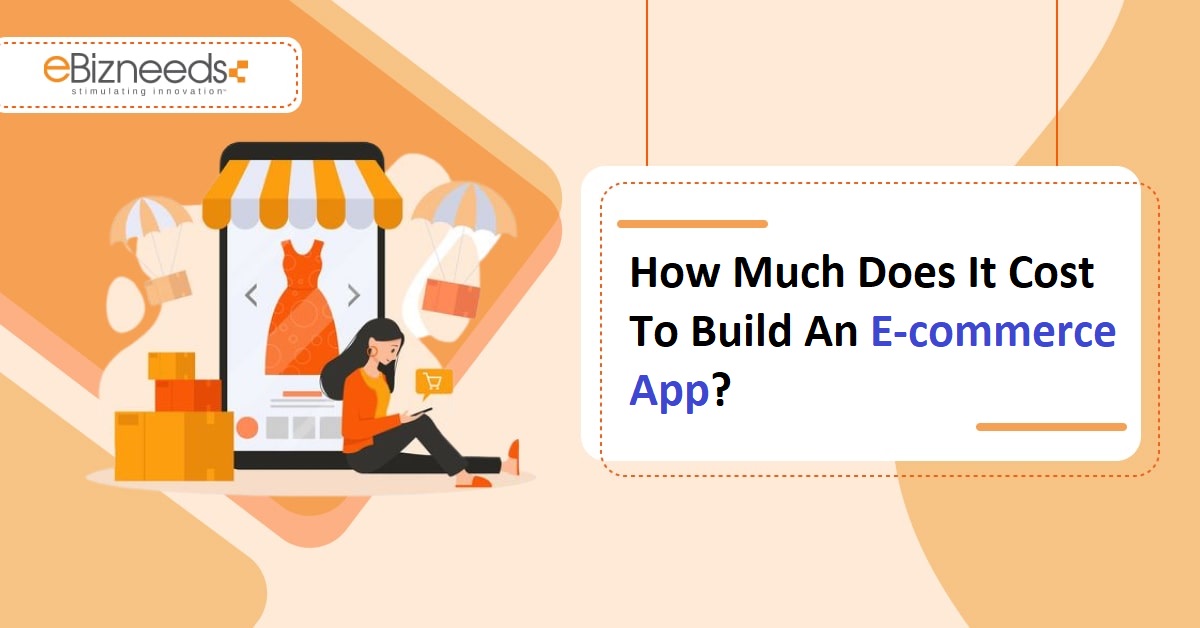Last updated on August 9th, 2024 at 12:42 pm
The eCommerce app development business is quickly growing with the dispatch of cell phones and different devices. Additionally, individuals love to buy numerous things on the web, like food, apparel, and adornments, and the sky’s the limit. So, an eCommerce application has become the go-to choice for clients worldwide for online shopping. Before jumping into the cost of eCommerce app development and monetization strategies, let’s start with what eCommerce app development is all about.
What is An eCommerce App?
An eCommerce app is a web or mobile app that makes users competent to purchase and sell products and services.
This eCommerce app lets you look at prices, browse products, check out of the store, add items to your cart, manage user accounts, and look at orders you’ve already made.
eCommerce apps are similar to recipe apps, web apps, and online product reviews.
It permits you to search for products on the websites. The popular eCommerce app considers Etsy, Amazon, and eBay.
eCommerce App Development: A Market Overview
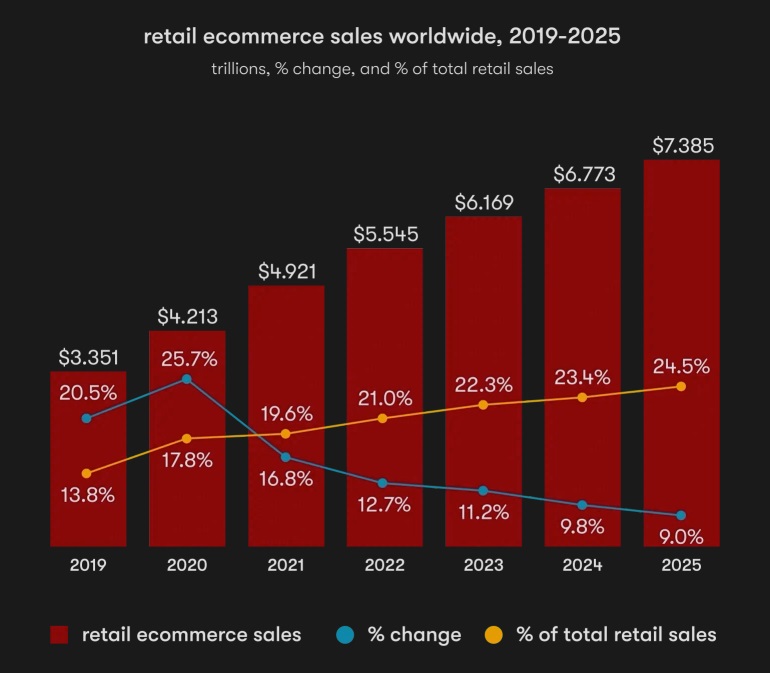

Here we have discussed some eye-opening statistics:
- According to Statista, in Q3 2022, the share of eCommerce in total US retail sales stood at 14.8%, higher than the past quarter.
- From July to September 2022, retail eCommerce sales in the US crossed 266 billion US dollars.
- It has the highest quarterly revenue in history.
- By 2025, online retail sales in the United States are expected to total 7.385 US dollars.
The estimates show that mobile apps are the future of online shopping businesses.
Other than this, there are important benefits to having an app. For example, better organization and more customer accountability.
Because many new businesses, entrepreneurs, small and medium-sized companies, and other projects are following the trend of eCommerce mobile app development.
Considering how expensive the eCommerce market is, and assuming you want to make an eCommerce app, we’ve got you covered.
Developing a productive eCommerce app requires considering one common request first. This helps ensure the app meets users’ needs. Taking this approach can lead to a more effective and useful eCommerce application.
Types of eCommerce Business App Models
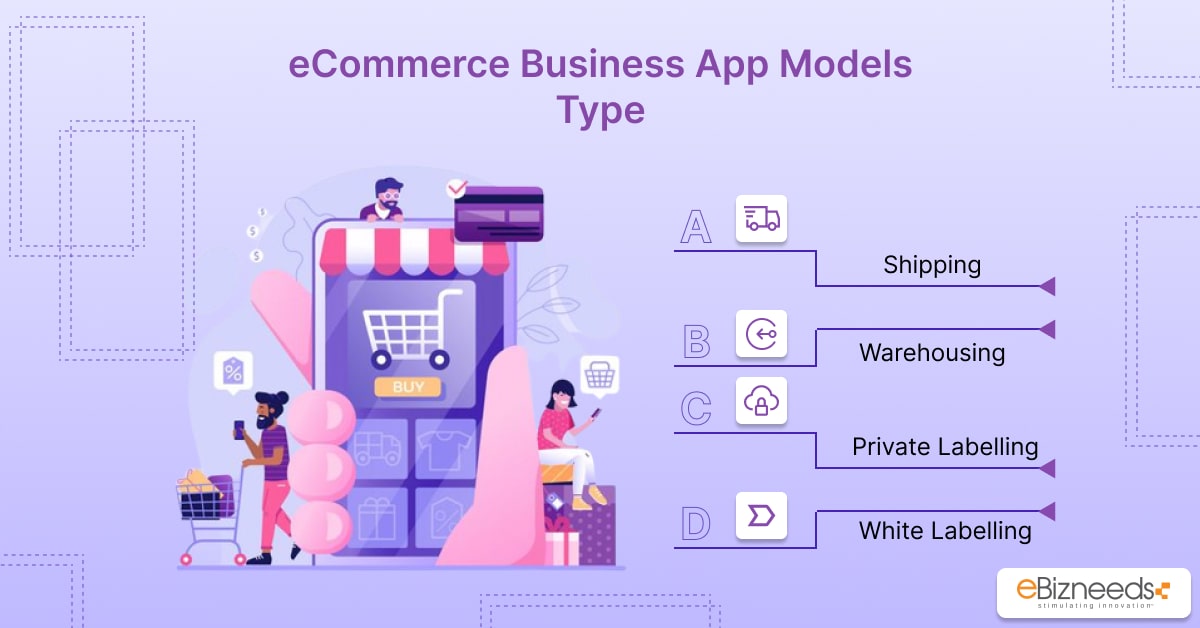

The next most significant thing to consider in the custom eCommerce website development guide is how you deal with logistics and warehousing.
While some people like to build their own product warehouses, others think of managing separate warehouse and logistics operations.
#1 Shipping
The most interesting point in the eCommerce development guide is how you manage coordination and warehousing.
While a few groups like to develop their item stockroom, others think of dealing with a different distribution centre and coordinating tasks.
The main type of eCommerce business is outsourcing. It lets you build your business outside of the store and take money from customers using advanced wallets.
The rest is up to your supplier. This frees you from directing stock, warehousing stock, or overseeing packaging. In any case, there’s a huge caution.
If your shippers are moderate, the quality is less than expected, or there are concerns with the solicitation, it is your responsibility.
You should also think about integrating a small application to manage the outsourcing and production network.
Having a logistics mobile app for your business will be helpful in a few ways.
#2 Warehousing
eCommerce businesses that sell wholesale products and store inventory need careful financial planning from the start.
Hence, you need to manage stock, screen client requirements, and track transportation information. It would be best if you placed assets in the appropriation community itself.
#3 Private Labelling
Organisations fabricate existing items in this model to explicitly meet the shopper’s necessities.
In any case, they prefer to collaborate with other eCommerce administration suppliers or transportation organizations. For instance, Amazon delivers goods to customers.
#4 White Labelling
You select an item that is now widely sold by another company, which is similar to private labeling.
But, in such a situation, you can plan your markup, bundle, and sell the product.
It is common in the beauty and health industries but more difficult to find in other areas.
Intuitive Benefits of the eCommerce Mobile App for Your Business
Before evaluating the eCommerce app development cost, let’s take a deep dive into the benefits of eCommerce apps:
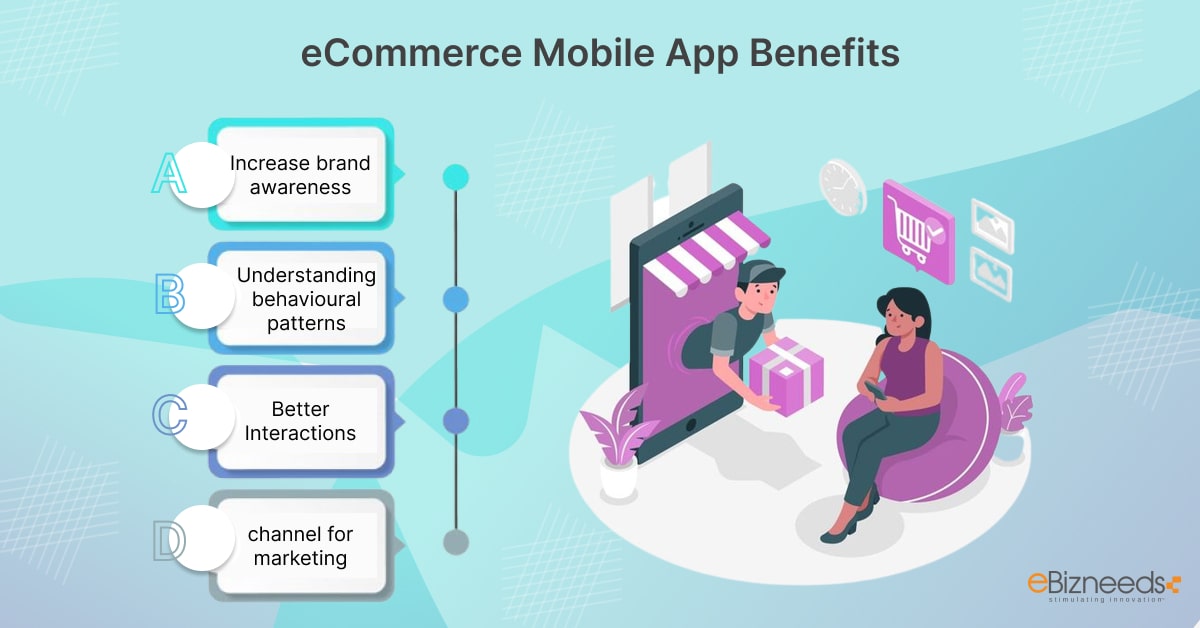

Increase Brand Awareness
E-commerce apps enable businesses to make direct connections with potential customers.
It also serves as a bridge between a brand and its customers to inform them about its products or services.
Understanding Behavioral Patterns
Through eCommerce apps, mobile app companies can collect the right information about users based on how they act.
It also assists them in understanding what their customers are looking for, and, as a result, they endorse specific offers and services to users with specific targeting.
Better Interactions
It doesn’t matter whether it is your favourite brand or another. There are more complexities to making a connection with the brand.
However, eCommerce apps help to keep users actively engaged and provide good customer service.
Channel for Marketing
eCommerce apps have a notification feature.
It assists in notifying the registered users about discounts or offers on their products or services.
So, it gives them a great place to advertise their business and work toward growth.
Choose A Monetization Model
When making an eCommerce mobile app, one of the most important things to remember is how to adapt your app.
Here are a few ways you can recoup the cost of an eCommerce app and grow your business’s income.
Offering in-app purchases
You can give your app some basic features that will let people buy things from it.
Freemium Model
Many organisations are using the freemium model in mobile applications for retail businesses because of its incredible potential benefit. In this model, you offer the application free of charge for download and use.
But you also offer a few “premium” features that customers can only use after paying a certain amount of money.
Subscription Model
Additionally, organizations worldwide use this model to expand their income stream.
Here, you permit the client to use your application free of charge. In any case, you give more advantages to clients when they buy into your application.
Numerous product recommendations organizations use this process to adapt their applications.
For example, the eCommerce behemoth Amazon provides customers with free access to Amazon Prime, a membership administration. It charges a particular amount of cash monthly or yearly to offer assistance.
eCommerce App Classification
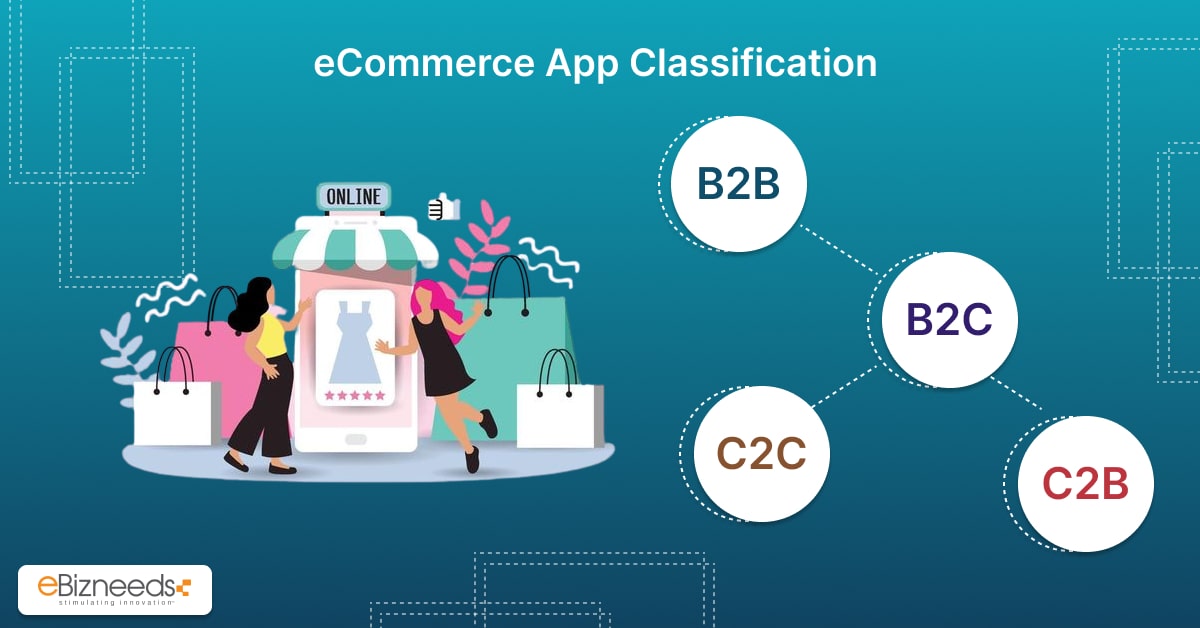

eCommerce application development requires effort, market data, a solid plan, and careful research on strategies.
Everything, from the cost of developing an e-commerce Android app to its distribution on various mobile commercial centres, should be covered.
Some eCommerce leaders may not know about the different types of eCommerce. Let’s look at them.
#1 B2B
A B2B model brightens by transferring items from one business to the next. While many organisations in this sector provide solutions for this platform, you can choose one that meets your business objectives in terms of choosing organisations and selling arrangements.
#2 B2C
The B2C part is what many individuals consider when they imagine eCommerce application advancement.
B2C is the most significant market, and you have tremendous quantities of the names you’ll see.
B2C deals are considered the standard retail model in which a company provides services to individuals, but the company is determined online rather than in a physical store.
You can also hope to execute mobile application development models for better outcomes in this classification.
Thus, arriving at your intended interest group will be simple.
#3 C2C
Made possible by the rising eCommerce business fragment, this C2C helps to create customer trust in eCommerce.
These objections grant buyers the right to trade, buy, and sell things. Because of this trade-off, the page charges a little commission.
Opening a C2C site requires smart planning. However, the verifiable accomplishments of platforms like eBay and Craigslist, different other closeouts, and requested regions have opened and promptly shut because of incredible models.
#4 C2B
C2B is another model many individuals don’t rapidly consider but are creating with regularity.
In this online exchange business, the purchaser offers products or organisations to associations. And it is by and large similar to a sole proprietorship serving a larger business.
Moreover, reverse trades, business associates like UpWork, and a couple of ordinary blog transformation frameworks like part-time affiliate marketing or Google AdSense fall under this heading.
Because of these eCommerce business platforms, organisations can decide to carry out this eCommerce application advancement instructional exercise. Also, a few models can be incorporated into your eCommerce application.
Steps to Create An eCommerce App
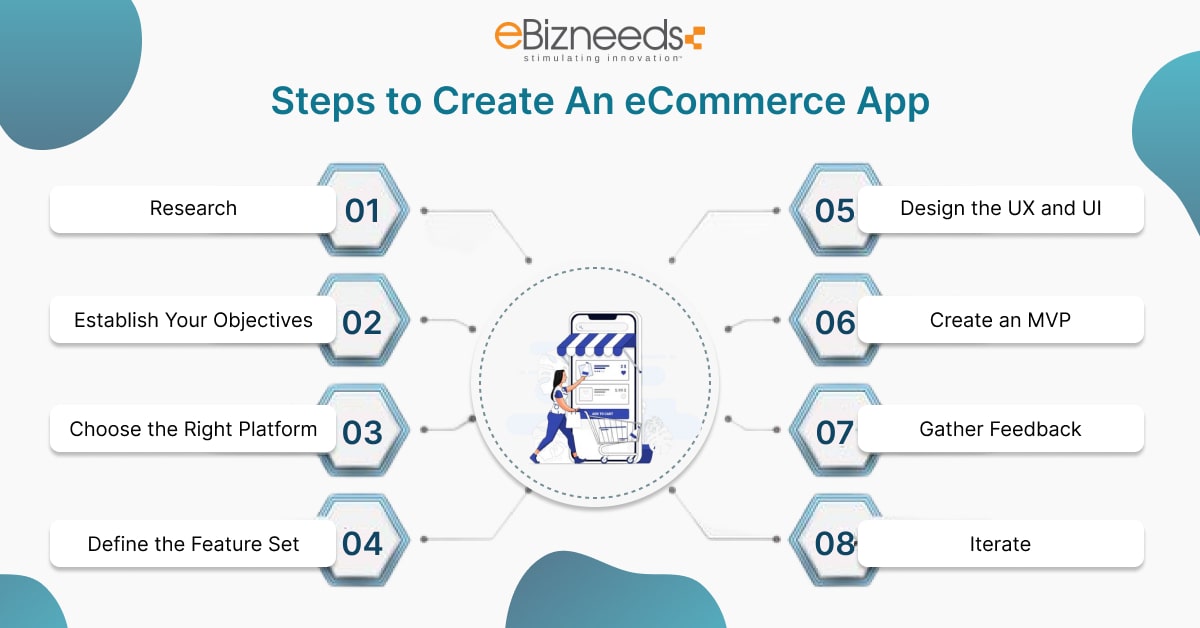

Mobile application development needs input from professionals in different sectors. It includes a subject matter expert from the eCommerce business in app development.
Before jumping to the next section, let’s dive right into developing an eCommerce app for both web and mobile.
Step 1: Research
In the initial step, you need to conduct research to address the customer’s needs and wants and the competitor’s analysis.
You can conduct competitor research and user interviews to assess the target audience’s patterns and behaviours.
It also supports illustrating the right app platform and making the feature set as applicable as possible for our potential audience.
Step 2: Establish Your Objectives
The basis of eCommerce mobile app development services is setting business goals. Let’s discuss some questions that will assist you in reaching your goals:
- What issues are you going to resolve?
- To whom will the product be sold?
- How do you know if it is effective?
Step 3: Choose the Right Platform
After understanding the users of the app and the functionalities it would perform, the next stage is to choose what sort of app is required.
It would be best if you kept an eye on inventory and development costs and chose the database, scalable framework, and CMS accordingly.
Using such information, you can decide whether to launch an Android app, an iOS app, or both. You need to target the mobile platform based on a target audience.
The tech stack is important for transforming a smart idea into a viable product. Different components need to be considered in the tech stack, such as:
- Backend processing on the server
- Frontend interface of the app
- Supporting technologies that offer app security and performance
- development platform with interfaces and libraries
Step 4: Define the Feature Set
You can now understand the issues your product is facing and which features of eCommerce mobile app development can satisfy end users.
Since you already have the expert opinion, user feedback, and trends to beat the competitors,
Step 5: Design the UX and UI
As discussed above, the eCommerce apps’ experience should go beyond in-person shopping. In this context, UI/UX design is a big opportunity for users. Design helps to establish your voice and business recognition among the target customers. For this, you can hire an eCommerce app developer to design the UI and UX.
Moreover, attractive visuals, colour systems, and smooth shifts from page to page create a positive image in the customer’s mind.
Step 6: Create an MVP
It would be best if you remembered to prioritise the product’s features. The MVP stage is where you need to emphasise the significant features of your eCommerce app. Rather than implementing the full-fledged product, continuous product evaluation is needed to fuel further amendments.
MVP aims to find out what users think about the product, cut down on development time, reduce risks, and make better use of resources.
Step 7: Gather Feedback
After releasing the MVP, it is time to capture feedback from the customers. It is the procedure to check how users communicate with your application, capture feedback, and address possible developments.
The feedback set is important in eCommerce app development because it assists you in figuring out what works for your potential audience and what doesn’t.
Step 8: Iterate
It is the final step where you need to make a constant update as per the eCommerce app market.
We can see that design is never constant if we assess the leading players in the eCommerce app sector. Because there is a need to make regular changes and adapt to the user’s needs.
Factors that Determine the Cost of eCommerce App Development
It is challenging to provide an accurate answer to the question, “What is the cost of eCommerce app development?”
Although all apps fall under the broad category of eCommerce apps, each may have its own differences in design and features.
Hence, different factors affect the cost of eCommerce app development. Let’s look at them more.
1. The Platform
It would be best to consider it a significant decision before developing the app. To develop this decision, you must include certain parameters, such as your audience, target demographics, and expected market reach.
The cost of eCommerce app development will vary depending on the mobile app development framework you choose.
Your app can either be native, web-based, or hybrid.
The most recognized platforms in the current market are Android and iOS.
You can choose either Android and iOS for your app or cross-platform app development for an app. It can also run on both iOS and Android.
2. Developer Location
The rate of mobile app development differs in distinct geographical areas. Generally, the developers take charge on a per-hourly basis.
Complex apps require more hours than simple apps.
eCommerce apps need some time to develop; hence, the development time is a considerable factor affecting the cost.
The app developer rate is higher in some nations, such as the USA, Australia, and Canada. It ranges between $100 and $200 per hour.
The hourly rate is relatively inexpensive in Eastern and Asian European nations.
For instance, in India, mobile app development costs range from $15 to $30 per hour. It is one of the reasons why outsourcing app development is highly popular in India and factors affecting the cost of development an e commerce app on a budget.
3. App Design
The visual picture that an app creates is significant for an eCommerce app. Hence, app design is an essential factor in the cost of eCommerce app development.
The app design considers different sections, such as screen design, icon design, and logo design.
The cost of developing eCommerce depends on the extent of customization or branding.
4. App Functions
The app’s characteristics and degree of complexity are determined by its features. Your ideas for mobile apps will determine how to proceed.
To make an e-commerce app more affordable, you might create it with only essential functionality.
However, you may also need to incorporate some cutting-edge features for your software to stand out and build a name for itself among rivals.
The cost of developing an e-commerce app rises along with the number and complexity of features.
For e-commerce applications, several fundamental functionalities are regarded as common necessities, such as:
- User login/registration
- Product catalogues
- Payment gateway
- Tracking orders
- Checkout
A simple e-commerce application may be created using these fundamental characteristics to market your items to target audiences.
In addition to these fundamental functions, advanced features may help improve your e-commerce application. These are:
- Social network integration
- Push notifications
- Multiple payment methods
- In-app chat
- Product search and filter
- Product ratings
- A wish list
Based on the latest trends in making mobile apps, the list will continue to grow.
When these advanced features are added to e-commerce applications, the cost of making them will go up.
As your business grows and changes, it is also possible to build a mobile app with simple features and add more complex ones as your business grows.
5. Application Maintenance
This step considers the non-observable elements affecting the cost of developing an eCommerce app.
When we first start developing an app, we often forget about it. Nevertheless, it is necessary for the long-term, effective operation of applications.
We built the software on platforms like Android and iOS, which often upgrade their operating systems.
Your app may need to be upgraded for it to function flawlessly under the latest platform changes.
So, this is a very important thing to think about when figuring out how much it will cost to build an ecommerce app development company.
The Cost of Developing An eCommerce Application
After reading the last paragraph, you can get an idea of the various factors contributing to the cost of developing an e-commerce application.
Now let’s talk about numbers and how to convert them to factor costs.
- Wireframe costs for applications with 2-3 screens go up to $500, and for additional screens, they might range from $1500 to $2500.
- The normal cost of UI/UX design ranges from $2000 to $2500. It might go up to $30,000 for complex applications.
- In general, it costs between $100,000 and $300,000 to build an e Commerce application.
- Depending on the high-level element incorporations and application complexity, the cost can reach $80,000.
- Testing and deployment costs could range from $1000 to $20000.
So, we can say that the overall cost of developing an eCommerce application ranges from around $30,000 to $200,000.
And it depends upon the application’s complexity and all the factors we discussed above.
Technology Stack for eCommerce Application Development
An eCommerce tech stack is a group of tools and technologies that help you run your business in a big way.
Developers who use various frameworks, programming languages, and tech stacks create the eCommerce app.
The examples given below are particularly appropriate for eCommerce app development. Hence, let’s dive deep into the tech stack.
|
Frontend and Backend Development |
CSS, HTML, and JavaScript |
|
Databases |
MongoDB, MySQL, PostgreSQL, Firebase Database, and DynamoDB |
|
Web Server |
Nginx and Apache |
|
Programming Language |
Scala, Python, PHP, React Native, Java, Laravel, and Flutter |
|
Storage |
Firebase Storage and AWS |
|
Social media marketing |
Buffer, Hootsuite, and Marketing 360 |
|
Inventory Management |
Lightspeed and Square for Retail |
|
CRM |
HubSpot, Nimble CRM, and Salesforce |
|
Payment Gateway |
Braintree, PayPal, and Stripe |
Team Structure for Developing eCommerce Application Development
In addition to looking for an eCommerce app development company, we need a full team of professional designers, developers, testers, project managers, and QA experts to oversee the whole development process.
- Android app developers
- AngularJS front-end developers
- iOS App Developers
- NodeJS back-end developers
- Quality Analyst
- Business Analyst
- UX/UI designers
- Project Manager
The Key Takeaways
It takes a lot of effort to operate and manage your business in this modern market driven by digital technology.
The success of an e-commerce business depends on a number of things. These are research into the market and the best business strategies and use of latest technology.
This blog discusses all the important parameters of building an eCommerce application.
It has the features and estimated costs that will help you make decisions in the future.
If you’re also looking for ways to improve your business, you should hire an e-commerce app development company like eBizneeds.
eBizneeds has more shopping carts experience making different ideas into useful products and offering customized solutions.
In fact, you can get a good estimate of how much your app ideas will cost by working with our professional developer team.
FAQs
Mobile app development involves creating software applications for different mobile devices.
If you want to build a mobile app, you must choose a mobile app development company that has worked on a wide range of mobile apps and stick to a tried-and-true development method.
Mobile app developers make sure the app has a thorough development plan, an easy-to-use interface, all of the necessary software packages that can be installed, and the right backend services to support it.
Native and hybrid mobile applications are the two primary categories.
A native app is mobile software that can be downloaded from the Google Play Store and the Apple App Store. Therefore, it is created specifically for an OS like Android or iOS.
Because a hybrid app only has to be written once and can operate on both platforms, creating one is quite simple. Comparatively speaking, native applications provide a better user experience than hybrid ones.
Formerly, businesses might have created applications that exclusively supported a certain platform. Most companies today seek to create applications that work on both the iOS and Android platforms since they both have significant market shares.
A typical application design cost will be between $25,000 and $30,000. The price of creating the app will increase to $35,000 if AI and customized features are included.



Naveen Khanna is the CEO of eBizneeds, a company renowned for its bespoke web and mobile app development. By delivering high-end modern solutions all over the globe, Naveen takes pleasure in sharing his rich experiences and views on emerging technological trends. He has worked in many domains, from education, entertainment, banking, manufacturing, healthcare, and real estate, sharing rich experience in delivering innovative solutions.
